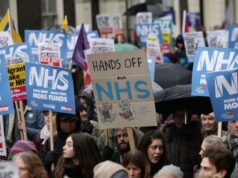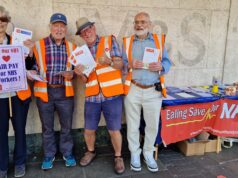Issue: 26
July 2015
This occasional newsletter is researched, written and edited by a group of concerned residents in Ealing, West London who want to preserve our NHS. We view the wholesale engagement of private, for-profit healthcare service suppliers as unnecessary, profligate and dangerous. Process improvement is what is needed in our NHS – not revolution.
Solace Centre Will Remain Open but as a Much, Much Smaller Facility. Will It Still be Viable?
The Solace mental health drop-in centre in Bowmans Close West Ealing, which was in danger of closure this year, has apparently won a reprieve until April 2016. However the funding model must change if the centre is to survive beyond this date. The London Borough of Ealing (LBE), who owns the centre, has looked at five options for alternative funding and an invitation to tender will be issued by LBE in September 2015.
The preferred option, which was agreed at the 16 June 2015 LBE Cabinet meeting, links the continued out-of-hours mental health service with a residential service at Marron House. Marron House is owned by LBE and it houses the Solace Centre. The service supplier will be London Cyrenians. London Cyrenians is a 43 year old charity which provides shelter and support across west London for over 500 single, vulnerable, homeless and mentally ill people. The option involves the conversion of much of the Solace centre into two additional supported living units on the Marron House site.
Activists are up in arms because this arrangement reduces the actual size of the new Solace to just one room and a small kitchen. The fine detail on how an arrangement might work with Solace users, Marron House residents, London Cyrenians, LBE and the NHS West London Mental Health Trust (WLMHT) has yet to be worked out. WLMHT has confirmed that it will continue its annual funding of £47,000 to support the Solace centre service.
Ealing Hospital
A minimalist version of the NHS ‘Shaping a Healthier Future’ plans for Ealing Hospital were aired at the North West London Joint Health Overview & Scrutiny Committee (JHOSC) meeting on 16 June 2015. The message carrier was the NHS NW London CCG ‘supergroup’ – the North West Collaboration of Clinical Commissioning Groups.
Here below is what the terse statement says about future hospital provision for the 340,000 residents across the 21 square miles of Ealing. I believe this statement has been the one consistently trotted out in recent years.
‘Ealing Hospital
Ealing Hospital is being modernised and redeveloped (as) a new 21st century facility for the local community. The hospital will have a local A&E and 24/7 GP-led Urgent Care Centre, with access to 24/7 specialist care, as well as a range of specialist services designed with – and for – the local community, such as a Diabetes Centre of Excellence.
Ealing will become a new local hospital for the whole of the local population. In particular, it will improve care for elderly patients, those with long term conditions and the most vulnerable members of the community by integrating primary and secondary care with community and social care. Services proposed include: access to specialist opinion; social care and psychiatry; a wide range of diagnostic services including pathology and radiology; the ability to admit people to beds on the hospital site for assessment, treatment, observation and rehabilitation; outpatients services; ‘Transition’ beds; an enhanced diagnostic service, comprising X-Ray, Ultrasound, CT and MRI scanning and ECG; a range of therapies, podiatry, audiology and dietetics; ophthalmology; education and research; a hospital and community pharmacy; a sexual health clinic; space for GP practices; a day assessment centre; pregnancy assessment centre; ambulatory chemotherapy; and renal dialysis.’
Some questions and comments come to mind which include:
+ Does ‘modernised’ mean updating and repurposing existing buildings?
+ Does ‘redeveloped’ mean demolish and new build? If so then no doubt a Private Finance Initiative (PFI) will come into play.
+ What exactly is a ‘local A&E’? There is no mention of an Intensive Care Unit or Intensive Care beds
+ What might ‘access to 24/7 specialist care, specialist consultant opinion, social care and psychiatry’ actually mean. Note that there is no mention of ‘on-site access’. Might it mean telephone access, email access, Skype access, ambulance access, guaranteed real time access to staff/beds/resources in other NHS hospitals in the region?
+ No mention anywhere of ‘mental health ‘service provision. If the oft stated NHS goal of treating physical and mental health issues in the same ‘Setting of Care’ has any validity then both physical and mental health care must be delivered in the new Ealing Hospital
+ ‘….integrating primary and secondary care with community and social care’. This is a truly laudable aspiration, but is outside the scope of the specification for a new local hospital on the Ealing Hospital site
+ No indication of how many hospital beds will be provided and for what purposes they will be used
+ No mention of any operating theatres
+ No mention of ante-natal and post-natal Maternity services on site
+ No indication of the timescale for creating this new 21st century healthcare facility
+ Where is the London North West Healthcare NHS Trust in all this? It’s the Trust which currently runs Ealing Hospital and (presumably) it’s the Trust who will deliver the medical services at the new Ealing Hospital. The ECCG is only involved in the purchasing of these services.
+ One of the biggest gripes about Ealing Hospital is the inadequate size of the car park. Surely, with the local population of Southall expected to expand by more than 10,000 people by 2026, a commitment to more car parking spaces is needed?
+ If this is truly going to be a local hospital for local people just how many Ealing or Southall residents are going to be involved in articulating the local needs and specifying the service mix for this new Ealing Hospital?
Healthwatch Ealing: A Sickly Patient?
Each Local Authority has a legal obligation to ‘commission’ and fund a local Healthwatch organisation. These local Healthwatch organisations are independent consumer champions for both health and social care. The Health and Social Care Act 2012 created the Healthwatch initiative.
I’ve often wondered why Healthwatch Ealing (HE) consistently fails to represent local residents’ concerns about current and planned ‘transformations’ to NHS services. Thousands have taken to the streets in recent years to demonstrate against the NHS ‘Shaping a Healthier Future’ plans to downgrade Ealing Hospital and close its Maternity Unit. But I’ve seen no sign of HE leading or even joining these demonstrations. On the day the Maternity Unit closed down HE’s web site proclaims details of improvements to local maternity services on its home page!
I recently spent some time perusing the HE constitution. I have to say that it does contain some peculiar clauses. For example it grants extraordinary powers to the housing and support charity Hestia. HE employs Hestia to provide a range of services which include accounting, IT and HR. (In fact all five HE employees are employed by Hestia). There is a historical link here as Hestia performed a similar role for HE’s precursor organisation, Ealing LINk. Another bizarre clause absolves HE from having to convene Annual General Meetings.
Anecdotal evidence suggests that the majority of EH Board members do not see HE as a campaigning organisation, although it’s quite clear that Healthwatch guidelines explicitly allow this. For some reason HE members cannot attend HE Board meetings even as observers.
2015/2016 is likely to be a challenging year for HE as its annual Local Authority grant will be reduced by £57,700 to £140,000. Elections are being held to create a new HE Board and there are rumours of a HE public meeting at Ealing Town Hall on 16 July 2015. Allegedly the composition of the new Board will be announced at this meeting. However as a member of HE, as at 1 July 2015 I have yet to be invited to this meeting.
HE could be transformed into a really useful open and transparent campaigning group which truly represents Ealing residents. Clearly a new constitution is required along with new leadership. I encourage residents to join HE at www.healthwatchealing.co.uk. If this process is problematic (and it can be) people can always leave a message with their contact details on 0800 652 7200.
NHS Mental Health Services in Ealing
I attended a meeting of the excellent mental health Carers’ Support Group based at NHS WLMHT’s Recovery East Team base at Avenue House in Acton on 9 June 2015. The group receives financial support from LBE. Around 30 carers attended to hear WLMHT’s Robert Murray present and answer questions. Robert is the Senior Manager for Planned and Primary Care Service Line. Interestingly two members of the Care Quality Commission (CQC) also attended. CQC has just completed an evaluation of the performance of WLMHT.
Robert outlined current and future planned changes to local mental health services in the context of the 2012 NHS NW London ‘Shaping a Healthier Future’ programme. He emphasised the goal of treating physical and mental health illnesses in the same ‘Setting Of Care’. The main thrust of achieving this is the ‘discharge’ of as many as possible mentally ill patients (‘service users’) from WLMHT care to GP/Primary Care. Those service users discharged are presumably those who have ‘recovered’ or who have stable behaviour and treatment regimes. Those who are not discharged and remain under WLMHT care are no doubt those who are unstable and/or with complex needs.
Currently 80% of Ealing GPs have contracted to provide mental health primary care. The 179 Ealing GPs are being organised into seven ‘clusters’ of GP surgeries and each cluster will have some specialist mental health support. Concerns were raised about those mentally ill patients whose GP has not contracted to provide mental health primary care. Doubts were also expressed about GPs’ abilities (even after some training) to be able to manage anti-psychotic medication regimes.
Two carers complained about the lack of consultant continuity in WLMHT. Seemingly every time their service user loved one meets a consultant it’s always a different person. Robert suggested that this was happening as consultants were being trained by meeting a wide range of service users in order to gain wide ranging experience.
A heart-rending case study was presented by a local carer about a mother and daughter – both service users – living together in a run-down LBE housing estate. These people are being exploited by drug dealers. Their flat has serious health and safety problems. They have difficulty living independent lives and looking after themselves. The situation became critical one evening when it was no longer safe for them to stay in the flat. All the best efforts of LBE and the NHS came to nothing. After standing outside their tower block for hours in the dark they finally finished up at Acton Police Station.
This case study highlights that there is no joined up out-of-hours emergency service in Ealing to provide health and social care. There are known to be around 10 residents on the estate with mental health problems. Their inability to live an independent life, to cope on a regular basis and to avoid being exploited can lead to their homes being trashed. This can result in eviction and homelessness. This ‘result’ can hardly be viewed as a successful outcome.
I asked how the NHS would measure the improvement achieved by changing the Setting Of Care for many mentally ill patients. He said the NHS uses a ‘Well-being Tool’ to measure mental health service user performance. As interesting as this measuring technique might be I asked whether an increase in the service user population might be an indication of success. This rather stopped him in his tracks. I further pointed out that probably everybody in the room knew of people with mental health problems who were yet to present themselves to the NHS. Getting more of these people into NHS diagnosis and treatment might indeed be an indicator of success. My second question was about time scale. He said it would take another 18 months to transform this Setting Of Care.
Improving Access to Pyschological Therapies (IAPT) in Ealing
Anecdotal evidence collected in recent months indicates progress is being made in making NHS psychological therapy treatment more readily available in Ealing. Self referral on 020 3313 5660 seems to result in a detailed telephone interview within a few days of first contact. NHS Cognitive Behavioural Therapy (CBT) specialists are readily available. NHS Counsellors are less available and there is up to a three month waiting list for treatment. However the IAPT service gives patients the option of using local, inexpensive, charity-based Counsellors who are more readily available.
WLMHT CEO Resigns
Steve Shrubb, WLMHT CEO, resigned his position on 19 June 2015. He had been in the job for just three years. After almost 40 years working in the NHS he is retiring on 20 November 2015 in order to care for his aging and ailing parents.
He’s had some tricky problems to deal with at WLMHT. These include psychologist whistle blower Dr Hayley Dare, poor CQC reports and the recent £3.9 million hole in the WLMHT accounts allied to potential fraud allegations.
NHS Hospitals Paid Out £3.3 Billion on Agency Fees and £600 Million to Management Consultancies in 2014
The Government is unhappy about the level of these costs and will implement some measures to bring about change by September 2015. These measures include:
+ A maximum hourly rate for agency doctors and nurses
+ A limit of £50,000 on all management consultancy contracts.
It’s hard to predict the impact of these measures. If the agency cap results in more staff taking up permanent positions in the NHS it is to be welcomed. If NHS bodies get round the management consultancy contract cap by issuing multiple £50,000 contracts then nothing will have been achieved.
NHS care.data is Still a Shambles
care.data is the NHS medical data service. The data is to be used in enhancing healthcare and social care. Development of the service has stuttered along since 2013. There have been constant fears expressed by various bodies about protecting confidential patient data. A key feature of the service is that patients can opt out of their data being used outside the NHS.
The confidential data of up to 700,000 NHS patients has been shared with insurance companies against their wishes. The breach happened in February 2015. The organisation responsible is the NHS Health and Social Care Information Centre. The data released was line-by-line data – every individual hospital episode for every patient, with unique pseudoanonymised identifiers.




